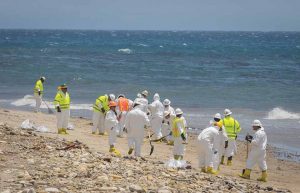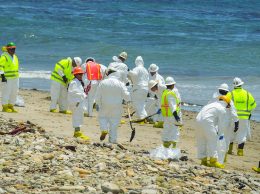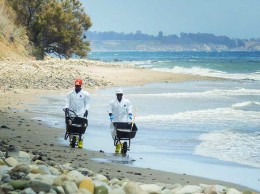Federal regulators say Plains failed to prevent Refugio oil spill
IN THIS ARTICLE
- Energy Topic
- pacbiztimes Author
By pacbiztimes Thursday, May 19th, 2016

Workers donned protective gear to clean up the Refugio oil spill.
Story updated at 5:20 p.m. May 19:
Plains All American Pipeline did not adequately protect its lines from corrosion, properly measure the worn pipes nor respond quickly enough to the Refugio oil spill, according to a final report from the Pipeline Hazardous Materials Safety Administration issued May 19.
PHMSA, the federal entity that regulated Plains pipelines, issued the report on the one-year anniversary of the spill that soiled the Gaviota Coast with more than 123,000 gallons of crude oil.
When Plains’ heavily corroded Line 901 leaked that morning, the controller in its Houston headquarters was distracted by another event and did not deem the low-pressure alarm that sounded as anything out of the ordinary, the report found.
Not only did the company allow the line to run about 35 minutes after the rupture, it restarted Line 901 before eventually shutting it down, according to the report.
“Control room staff training lacked formalized and succinct requirements, including emergency shutdown and leak detection system functions,” the report reads. “The pipeline supervisory control and data acquisition (SCADA) system did not have safety-related alarms established at values sufficient to alert the control room staff to the release at this location.”
The 510-page report indicated that Plains did not adhere to federal safety standards including emergency shutdown and leak detection system functions such as alarms, one of numerous findings of unsatisfactory safety and preparedness measures.
“Line 901 pipeline ruptured at approximately 56 percent of the maximum operating pressure,” the report reads. “Although the operational events that occurred on the morning of the release were abnormal, this should not have caused the release if the pipeline’s integrity had been maintained to federal standards.”
Results from Plains’ in-line inspection on May 6, just 13 days before the spill, revealed two critical parts of the pipeline that were up to 86 percent corroded. The PHMSA report said that Plains’ inspection, which was incomplete at the time of the spill, did not accurately convey the amount of corrosion.
“The report demonstrates that the lengths and widths of the anomalies were under-called (underestimated) in many cases, however many were also over-called,” the report reads.
Moisture seeped in between the pipeline’s coating and insulation, causing it to crack. But Plains did not identify the corrosion under the insulation as a “risk-driving threat.”
The part of the line that ruptured was reported in 2012 as 45 percent corroded. Plains’ integrity management plan added 10 percent to the risk threshold and added shrink sleeves at the repair welds. Plains should have excavated the section of the pipe that failed, the report said.
“Industry practices recognize that an impressed current system like the one utilized on Line 901 cannot protect an insulated steel pipeline should the coating (tape wrap over insulation) become compromised,” the report reads.
The company did not notify the proper authorities of the leak for more than three hours as it disputed the source of the oil. Federal pipeline safety regulations require notification at the “earliest practicable moment” following the release. Santa Barbara Fire Department personnel were the first to report the leak.
“The oil spill response plan required by 49 C.F.R. §194 did not account for a culvert near the release site that traversed the Pacific Coast Highway and Amtrak railroad tracks,” the report reads. “This culvert provided a quick flow path between the pipeline ROW and the Pacific Ocean, thereby allowing crude oil to flow easily towards Refugio State Beach and the ocean.
Prior to Refugio oil spill, Lines 901 and 903 had four small releases meeting PHMSA reportable criteria, but Plains did not report them, according to the report.
Plains took the county to court to evade local pipeline oversight, which means that it did not have to install automatic shut-off valves on its lines. Lines 901 and 903 were under the generally more lax jurisdiction of the federal government until Plains removed its Federal Energy Regulatory Commission tariffs in February and April, respectively. If they had the critical safety tool and were subject to state and local regulation, like every other pipeline in the county, the spill may have been prevented, officials said.
“Based on the FERC filing, Lines 901 and 903 were classified as interstate pipelines, pursuant to 49 U.S.C. § 60101(7), as facilities used to transport hazardous liquid in interstate or foreign commerce, and as such, were regulated by PHMSA as interstate pipelines,” the report reads.
So far, Plains has paid the $1.9 million in damages that Santa Barbara County has requested.
The city of Santa Barbara announced on May 18 that it filed a $2.2 million claim against Plains for lost revenue. The city said economic damages are ongoing and its analysis will be completed in the coming months.
“The release of today’s report marks the next step in determining what actually happened so that we can fully understand what caused the failure, hold those responsible accountable for the harm done to the Central Coast community, and apply the lessons learned from the spill in federal safety standards,” Rep. Lois Capps, D-Santa Barbara, said in a statement. “With millions of miles of pipeline operating around the country, the safety of communities across the country depends on it.”
• Contact Alex Kacik at akacik@pacbiztimes.com.










